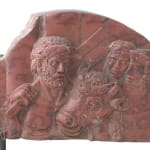Red Jasper Sculpture of a Roman Sacrifice, 16th Century CE - 18th Century CE
Jasper
7.75 x 4
PF.0174
Further images
In the shape of a tondo, or composition within a circle, this scene depicts a chief priest to the left and two attendants to the right. The priest, bearded and...
In the shape of a tondo, or composition within a circle, this scene depicts a chief priest to the left and two attendants to the right. The priest, bearded and with a full head of hair adorned with a wreath, stands behind the head of the sacrificial bull and looks toward his right. His right hand holds the fasces, originally held by Roman lictores, which consisted of a bundle of reeds tied around the handle of an axe. Lictores served as the corps of body guards for important magistrates. The reeds and axe symbolized their ability to arrest, punish, and (in the earlier periods) execute. The two attendants are likewise bearded with wreathed hair. The scene takes place within a colonnaded environment with its sacrificial altar to the far left of the composition. This Neo-Roman work of art is based on actual reliefs of the Roman Imperial Period which depict sacrificial processions. The use of red jasper is in keeping with the known Roman Imperial penchant for exploiting the decorative effects of colored stone. As such it is evocative of the grandeur of Roman art at its best. References:
D. E. Strong, Roman Imperial Sculpture (London 1961), figure 51 (the Cancelleria relief); figure 52 (the Suovetaurilia relief); passim; and H. Mielsch, Buntmarmore aus Rom (Berlin 1985), for the use of colored marbles by the Romans.
D. E. Strong, Roman Imperial Sculpture (London 1961), figure 51 (the Cancelleria relief); figure 52 (the Suovetaurilia relief); passim; and H. Mielsch, Buntmarmore aus Rom (Berlin 1985), for the use of colored marbles by the Romans.





